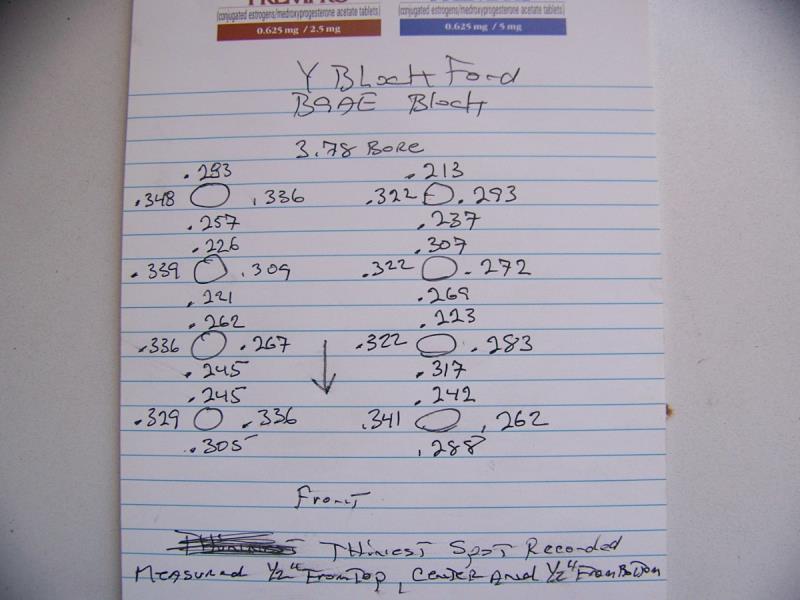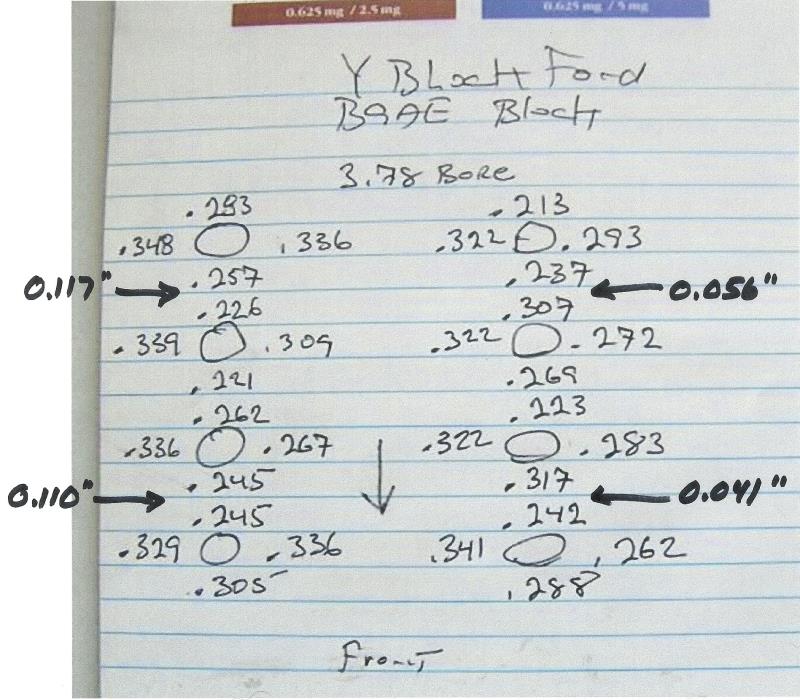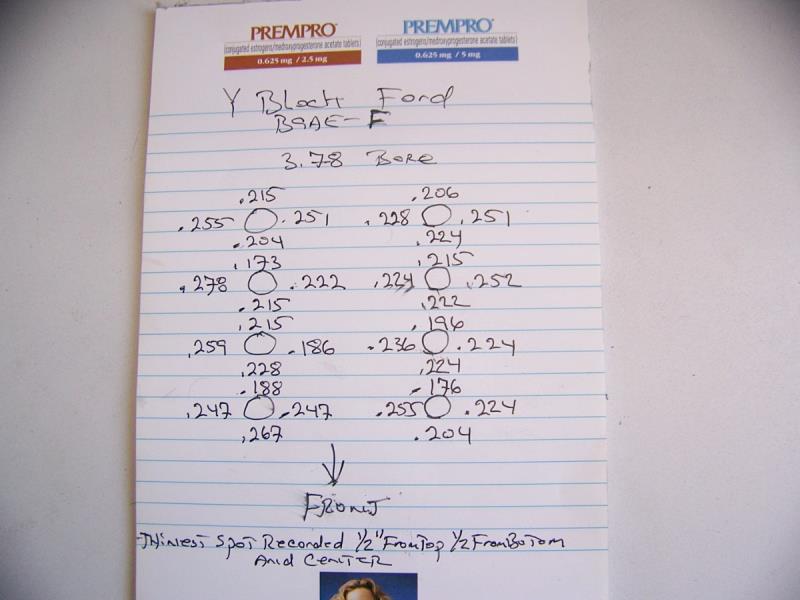|
By Cliff - 10 Years Ago
|
This is my Dragster Block that I just tested
|
|
By speedpro56 - 10 Years Ago
|
|
Looks like a great block to use with excellent cylinder wall thickness.
|
|
By Ted - 10 Years Ago
|
Cliff. I hate to nitpick but those sonic test numbers look abnormally ‘thick’ for a B9AE block. Before boring the block based on those numbers, I’ll suggest double checking the calibration on the sonic test unit. On my own testers, I check the calibration before each use. In your case, it would be prudent to calibrate the tester against the same type of ‘iron’ used in the Ford cylinder walls. I have a collection of various sections of cylinder walls from the different manufacturers of blocks and these all check differently if not readjusting the sonic tester calibration accordingly. All these sections are machined with a step so that the ‘span’ on the tester can be accurately set and/or verified.
In your case, a quick double check would be to use a drill bit or feeler gauge between the cylinders walls as seen at the freeze plugs. This would help to validate your readings. If you can stick a 7/32” drill bit between the cylinders, then there’s a problem with the initial sonic test readings. I have reposted your sheet with the calculated distances between the cylinder walls (based on your readings) that you can access from the outside of the block. If you get actual measurements that are significantly greater than the calculated values, then you will know to recalibrate the sonic tester.

Let us know what you come up with as there have been some very thick blocks out there; I personally haven’t seen one of those being a B9AE block yet.
|
|
By Cliff - 10 Years Ago
|
|
Hi Ted, I did calibrate the tester before testing, however I can insert a 7/32 drill between cylinders, tight on the left side loose on the right side I have a broken block here and will take and cut out a piece and check to see what's up, this block came out of a truck, also it has been acid dipped to clean out the rust, this is a B9AE-F Block
|
|
By Cliff - 10 Years Ago
|
Ted your 100% correct, Measured a .330 piece from a block and my sonic checker showed .411 even after calibrating, so more work to do, thank you for correcting me.
Cliff
|
|
By Cliff - 10 Years Ago
|
New Test, this is going to 3.810
|
|
By Ted - 10 Years Ago
|
|
Cliff. That block looks to be a good starting point. Are you looking at using boost?
|
|
By Cliff - 10 Years Ago
|
|
Hi, no boost, 3.810 Bore, 3.60 Stroke, 6.370 rod, 13.48 comp, 280Deg @50, trend lifters in a 1500lb car (approx)
|
|
By OlWeldinrig - 10 Years Ago
|
How thin is too thin?I have 312 block I want to use which has a rough measurement of about .055 over.How much more can a guy Bore these blocks too safely?
Thanks Dave
|
|
By PF Arcand - 10 Years Ago
|
Sounds like your 312" block is close to 0.060" over. That seems to be about the practicle limit. To go bigger the block should be sonic tested. Some builders have gone to 3.9"+ but that leaves thin walls & no room for a cleanup rebore. Factory available pistons only went to 0.040" over.
|
|
By Ted - 10 Years Ago
|
56F250 (12/21/2015)
How thin is too thin? I have 312 block I want to use which has a rough measurement of about .055 over. How much more can a guy Bore these blocks too safely? Thanks Dave
Most 292/312 Y blocks will safely bore to 0.060” over their stock sizes; there are exceptions to this in that extreme core shift will limit even this amount. If core shift is present and not compensated for up front, then the possibility is much higher for a cracked cylinder or cylinder wall distortion early on. Upon sonic checking the cylinders and documenting the direction or location of core shift, then the cylinders can be offset bored so that the cylinder wall thicknesses around its perimeter will be more uniform.
My own preference is at least 0.125” for cylinder wall thicknesses on the thrust sides and a minimum of 0.095” between the cylinders (non-thrust sides). The anticipated performance level will dictate to a large degree the minimum cylinder wall thickness amounts.
|
|
By OlWeldinrig - 10 Years Ago
|
Thanks Ted,
We will check it out.And the same time Wow only an 8th of an inch.Thought you needed more meat than that.
|